Detecting and Attributing Evapotranspiration Deviations Using Dynamical Downscaling and Convection-Permitting Modeling over the Tibetan Plateau
Abstract
1. Introduction
2. Model, Datasets, and Methods
2.1. Model and Configurations
2.2. Datasets
2.3. Methods
3. Results
3.1. Annual and Seasonal Mean ET
3.2. ET over Dominant Land-Use Categories
3.3. Attribution of ET Deviations
4. Discussion
4.1. Uncertainties of Usage Data
4.2. Parameterizations of the Land-Surface Process
5. Conclusions
Author Contributions
Funding
Institutional Review Board Statement
Informed Consent Statement
Data Availability Statement
Acknowledgments
Conflicts of Interest
References
- Bothe, O.; Fraedrich, K.; Zhu, X.H. Large-scale circulations and Tibetan Plateau summer drought and wetness in a high-resolution climate model. Int. J. Climatol. 2011, 31, 832–846. [Google Scholar] [CrossRef]
- Yao, T.D.; Masson-Delmotte, V.; Gao, J.; Yu, W.S.; Yang, X.X.; Risi, C.; Sturm, C.; Werner, M.; Zhao, H.B.; He, Y.; et al. A review of climatic controls on δ18O in precipitation over the Tibetan Plateau: Observations and simulations. Rev. Geophys. 2013, 51, 525–548. [Google Scholar] [CrossRef]
- Lu, C.X.; Yu, G.; Xie, G.D. Tibetan Plateau serves as a water tower. IEEE Trans. Geosci. Remote Sens. 2005, 5, 3120–3123. [Google Scholar]
- Xu, X.D.; Lu, C.G.; Shi, X.H.; Gao, S.T. World water tower: An atmospheric perspective. Geophys. Res. Lett. 2008, 35, 1–5. [Google Scholar] [CrossRef]
- Guo, D.L.; Wang, H.J. The significant climate warming in the northern Tibetan Plateau and its possible causes. Int. J. Climatol. 2011, 32, 1775–1781. [Google Scholar] [CrossRef]
- Krause, P.; Biskop, S.; Helmschrot, J.; Flügel, W.-A.; Kang, S.; Gao, T. Hydrological system analysis and modelling of the Nam Co basin in Tibet. Adv. Geosci. 2010, 27, 29–36. [Google Scholar] [CrossRef]
- Huntington, T.G. Evidence for intensification of the global water cycle: Review and synthesis. J. Hydrol. 2006, 319, 83–95. [Google Scholar] [CrossRef]
- Yin, Y.H.; Wu, S.H.; Zhao, D.S. Past and future spatiotemporal changes in evapotranspiration and effective moisture on the Tibetan Plateau. J. Geophys. Res. Atmos. 2013, 118, 10850–10860. [Google Scholar] [CrossRef]
- Kuang, X.X.; Jiao, J.J. Review on climate change on the Tibetan Plateau during the last half century. J. Geophys. Res. 2016, 121, 3979–4007. [Google Scholar] [CrossRef]
- Oki, T.; Kanae, S. Global hydrological cycles and world water resources. Science 2006, 313, 1068–1072. [Google Scholar] [CrossRef]
- Jung, M.; Reichstein, M.; Ciais, P.; Seneviratne, S.I.; Sheffield, J.; Goulden, M.L.; Bonan, G.; Cescatti, A.; Chen, J.Q.; de Jeu, R.; et al. Recent decline in the global land evapotranspiration trend due to limited moisture supply. Nature 2010, 467, 951–954. [Google Scholar] [CrossRef]
- Wang, K.C.; Dickinson, R.E.; Wild, M.; Liang, S.L. Evidence for decadal variation in global terrestrial evapotranspiration between 1982 and 2002:1. Model development. J. Geophys. Res. 2010, 115, D20112. [Google Scholar] [CrossRef]
- Douville, H.; Ribes, A.; Decharme, B.; Alkama, R.; Sheffield, J. Anthropogenic influence on multidecadal changes in reconstructed global evapotranspiration. Nat. Clim. Change 2013, 3, 59–62. [Google Scholar] [CrossRef]
- Gao, G.; Chen, D.L.; Xu, C.Y.; Simelton, E. Trend of estimated actual evapotranspiration over China during 1960–2002. J. Geophys. Res. 2007, 112, D11120. [Google Scholar] [CrossRef]
- Yang, K.; Ye, B.S.; Zhou, D.G.; Wu, B.Y.; Foken, T.; Qin, J.; Zhou, Z.Y. Response of hydrological cycle to recent climate changes in the Tibetan Plateau. Clim. Chang. 2011, 109, 517–534. [Google Scholar] [CrossRef]
- Zhang, Y.Q.; Liu, C.M.; Tang, Y.H.; Yang, Y.H. Trends in pan evaporation and reference and actual evapotranspiration across the Tibetan Plateau. J. Geophys. Res. 2007, 112, D12110. [Google Scholar] [CrossRef]
- Li, X.P.; Wang, L.; Chen, D.L.; Yang, K.; Wang, A.H. Seasonal evapotranspiration changes (1983–2006) of four large basins on the Tibetan Plateau. J. Geophys. Res. Atmos. 2014, 119, 13079–13095. [Google Scholar] [CrossRef]
- Yin, Y.H.; Wu, S.H.; Zhao, D.S.; Zheng, D.; Pan, T. Modeled effects of climate change on actual evapotranspiration in different eco-geographical regions in the Tibetan Plateau. J. Geogr. Sci. 2013, 23, 195–207. [Google Scholar] [CrossRef]
- Gao, Y.H.; Xiao, L.H.; Chen, D.L.; Chen, F.; Xu, J.W.; Xu, Y. Quantification of the relative role of land-surface processes and large-scale forcing in dynamic downscaling over the Tibetan Plateau. Clim. Dyn. 2017, 48, 1705–1721. [Google Scholar] [CrossRef]
- Wang, X.D.; Zhong, X.H.; Fan, J.R. Spatial distribution of soil erosion sensitivity in the Tibet Plateau. Pedosphere 2005, 15, 465–472. [Google Scholar]
- Cui, M.Y.; Wang, J.B.; Wang, S.Q.; Yan, H.; Li, Y.N. Temporal and spatial distribution of evapotranspiration and its influencing factors on Qinghai Tibet Plateau from 1982 to 2014. J. Res. Ecol. 2019, 10, 213–224. [Google Scholar]
- Li, Z.Y.; Liu, X.H.; Ma, T.X.; Kejia, D.; Zhou, Q.P.; Yao, B.Q.; Niu, T.L. Retrieval of the surface evapotranspiration patterns in the alpine grassland-wetland ecosystem applying SEBAL model in the source region of the Yellow River, China. Ecol. Modell. 2013, 270, 64–75. [Google Scholar] [CrossRef]
- Xue, Z.S.; Lyu, X.G.; Chen, Z.K.; Zhang, Z.S.; Jiang, M.; Zhang, K.; Lyu, Y.L. Spatial and temporal changes of Wetlands on the Qinghai-Tibetan Plateau from the 1970s to 2010s. Chin. Geogr. Sci. 2018, 28, 935–945. [Google Scholar] [CrossRef]
- Zhang, Y.S.; Ohata, T.; Kadata, T. Land-surface hydrological processes in the permafrost region of the eastern Tibetan Plateau. J. Hydrol. 2003, 283, 41–56. [Google Scholar] [CrossRef]
- Wang, B.B.; Ma, Y.M.; Su, Z.B.; Wang, Y.; Ma, W.Q. Quantifying the evaporation amounts of 75 high-elevation large dimictic lakes on the Tibetan Plateau. Sci. Adv. 2020, 6, eaay8558. [Google Scholar] [CrossRef] [PubMed]
- Leuning, R.; Zhang, Y.Q.; Rajaud, A.; Cleugh, H.; Tu, K. A simple surface conductance model to estimate regional evaporation using MODIS leaf area index and the Penman-Monteith equation. Water Resour. Res. 2008, 44, 10. [Google Scholar] [CrossRef]
- Su, Z. The surface energy balance system (SEBS) for estimation of turbulent heat fluxes. Hydrol. Earth Syst. Sc. 2002, 6, 85–99. [Google Scholar] [CrossRef]
- Chen, X.; Su, Z.; Ma, Y.; Liu, S.; Yu, Q.; Xu, Z. Development of a 10-year (2001–2010) 0.1 data set of land-surface energy balance for mainland China. Atmos. Chem. Phys. 2014, 14, 13097–13117. [Google Scholar] [CrossRef]
- Wang, K.C.; Dickinson, R.E. A review of global terrestrial evapotranspiration: Observation, modeling, climatology, and climatic variability. Rev. Geophys. 2012, 50, RG2005. [Google Scholar] [CrossRef]
- Yan, H.; Wang, S.Q.; Billesbach, D.; Oechel, W.; Zhang, J.H.; Meyers, T.; Martin, T.A.; Matamala, R.; Baldocchi, D.; Bohrer, G. Global estimation of evapotranspiration using a leaf area index-based surface energy and water balance model. Remote. Sens. Environ. 2012, 124, 581–595. [Google Scholar] [CrossRef]
- Li, X.L.; Liang, S.L.; Yuan, W.P.; Yu, G.R.; Chegn, X.; Chen, Y.; Zhao, T.B.; Feng, J.M.; Ma, Z.G.; Ma, M.G. Estimation of evapotranspiration over the terrestrial ecosystems in China. Echohyrology 2014, 7, 139–149. [Google Scholar] [CrossRef]
- Chen, J.L.; Wen, J.; Kang, S.C.; Meng, X.H.; Yang, X.Y. The evapotranspiration and environmental controls of typical underlying surfaces on the Qinghai-Tibetan Plateau. Sci. Cold Arid Reg. 2021, 13, 53–61. [Google Scholar]
- Xue, B.L.; Wang, L.; Li, X.P.; Yang, K.; Chen, D.L.; Sun, L.T. Evaluation of evapotranspiration estimates for two river basins on the Tibetan Plateau by a water balance method. J. Hydrol. 2013, 492, 290–297. [Google Scholar] [CrossRef]
- Giorgi, F.; Francisco, R. Evaluating uncertainties in the prediction of regional climate change. Geophys. Res. Lett. 2000, 27, 1295–1298. [Google Scholar] [CrossRef]
- Mearns, L.; Team, N. The North American Regional Climate Change Assessment Program (NARCCAP): Overview of phase II results. In Proceedings of the IOP Conference Series: Earth and Environmental Science, Copenhagen, Denmark, 10–12 March 2009. [Google Scholar]
- Gao, Y.H.; Leung, L.R.; Salathe, E.P.; Dominguez, F.; Nijssen, B.; Lettenmaier, D.P. Moisture flux convergence in regional and global climate models: Implications for droughts in the southwestern United States under climate change. Geophys. Res. Lett. 2012, 39, L09711. [Google Scholar] [CrossRef]
- Leung, L.R.; Kuo, Y.H.; Tribbia, J. Research needs and directions of regional climate modeling using WRF and CCSM. Bull. Am. Meteorol. Soc. 2006, 87, 1747–1752. [Google Scholar] [CrossRef]
- Jacob, D.; Barring, L.; Christensen, O.B.; Christensen, J.H.; de Castro, M.; Deque, M.; Giorgi, F.; Hagemann, S.; Hirschi, M.; Jones, R.; et al. An inter-comparison of regional climate models for Europe: Model performance in present-day climate. Clim. Chang. 2007, 81, 31–52. [Google Scholar] [CrossRef]
- Glisan, J.M.; Gutowski, W.J.; Cassano, J.J.; Higgins, M.E. Effects of spectral nudging in WRF on arctic temperature and precipitation simulations. J. Clim. 2013, 26, 3985–3999. [Google Scholar] [CrossRef]
- Huang, Z.Y.; Zhong, L.; Ma, Y.M.; Fu, Y.F. Development and evaluation of spectral nudging strategy for the simulation of summer precipitation over the Tibetan Plateau using WRF (v4.0). Geosci. Model Dev. 2021, 14, 2027–2841. [Google Scholar] [CrossRef]
- Deque, M.; Jones, R.G.; Wild, M.; Giorgi, F.; Christensen, J.H.; Hassell, D.C.; Vidale, P.L.; Rockel, B.; Jacob, D.; Kjellstrom, E. Global high resolution versus limited area model climate change projections over Europe: Quantifying confidence level from PRUDENCE results. Clim. Dyn. 2005, 25, 653–670. [Google Scholar] [CrossRef]
- Gao, X.J.; Xu, Y.; Zhao, Z.C.; Pal, J.S.; Giorgi, F. On the role of resolution and topography in the simulation of East Asia precipitation. Theor. Appl. Climatol. 2006, 86, 173–185. [Google Scholar] [CrossRef]
- Giorgi, F.; Bates, G.T.; Nieman, S.J. Simulation of the arid climate of the southern Great Basin using a regional climate model. Bull. Am. Meteorol. Soc. 1992, 73, 1807–1822. [Google Scholar] [CrossRef]
- Laprise, R.; Caya, D.; Giguere, M.; Bergeron, G.; Boer, G.J.; McFarlane, N.A. Climate and climate change in western Canada as simulated by the Canadian regional climate model. Atmos. Ocean 1998, 36, 119–167. [Google Scholar] [CrossRef]
- Li, S.S.; Lyu, S.H.; Gao, Y.H.; Zhang, Y. Effect of different horizontal resolution on simulation of precipitation in Qilian Mountain. Plateau Meteor. 2005, 24, 496–502. [Google Scholar]
- Mearns, L.O.; Gutowski, W.; Jones, R.; Leung, R.; Yun, Q. A regional climate change assessment program for North America. Eos. Trans. Am. Geophys. Union 2009, 90, 311. [Google Scholar] [CrossRef]
- Zhang, Y.X.; Duliere, V.; Mote, P.W.; Salathe, E.P. Evaluation of WRF and HadRM mesoscale climate simulations over the U.S. Pacific Northwest. J. Clim. 2009, 22, 5511–5526. [Google Scholar] [CrossRef][Green Version]
- Gao, Y.H.; Xu, J.W.; Chen, D.L. Evaluation of WRF mesoscale climate simulations over the Tibetan Plateau during 1979–2011. J. Clim. 2015, 28, 2823–2841. [Google Scholar] [CrossRef]
- Lin, C.G.; Chen, D.L.; Yang, K.; Ou, T.H. Impact of model resolution on simulating the water vapor transport through the central Himalayas: Implication for models’ wet bias over the Tibetan Plateau. Clim. Dyn. 2018, 51, 3195–3207. [Google Scholar] [CrossRef]
- Gao, Y.H.; Chen, F.; Miguez-Macho, G.; Li, X. Understanding precipitation recycling over the Tibetan Plateau using tracer analysis with WRF. Clim. Dyn. 2020, 55, 2921–2937. [Google Scholar] [CrossRef]
- Gao, Y.H.; Chen, F.; Jiang, Y.S. Evaluation of a convection-permitting modeling of precipitation over the Tibetan Plateau and its influences on the simulation of snow-cover fraction. J. Hydrometeorol. 2020, 21, 1531–1548. [Google Scholar] [CrossRef]
- Arakawa, A. The cumulus parameterization problem: Past, present, and future. J. Clim. 2004, 17, 2493–2525. [Google Scholar] [CrossRef]
- Brockhaus, P.; Lüthi, D.; Schär, C. Aspects of the diurnal cycle in a regional climate model. Meteorol. Z. 2008, 17, 433–443. [Google Scholar] [CrossRef]
- Prein, A.F.; Langhans, W.; Fosser, G.; Ferrone, A.; Ban, N.; Goergen, K.; Keller, M.; Tolle, M.; Gutjahr, O.; Feser, F. A review on regional convection-permitting climate modeling: Demonstrations, prospects, and challenges. Rev. Geophys. 2015, 53, 323–361. [Google Scholar] [CrossRef] [PubMed]
- Romps, D.M. A direct measure of entrainment. J. Atmos. Sci. 2010, 67, 1908–1927. [Google Scholar] [CrossRef]
- Song, X.; Zhang, G.J. Convection parameterization, tropical pacifific double ITCZ, and upper-ocean biases in the NCAR CCSM3: Part I. Climatology and atmospheric feedback. J. Clim. 2009, 22, 4299–4315. [Google Scholar] [CrossRef]
- Ou, T.H.; Chen, D.L.; Chen, X.C.; Lin, C.G.; Yang, K.; Lai, H.W.; Zhang, F.Q. Simulation of summer precipitation diurnal cycles over the Tibetan Plateau at the gray-zone grid spacing for cumulus parameterization. Clim. Dyn. 2020, 54, 3525–3539. [Google Scholar] [CrossRef]
- Prein, A.F.; Gobiet, A.; Suklitsch, M.; Truhetz, H.; Awan, N.K.; Keuler, K.; Georgievski, G. Added value of convection permitting seasonal simulations. Clim. Dyn. 2013, 41, 2655–2677. [Google Scholar] [CrossRef]
- Skamarock, W.C. Evaluating mesoscale NWP models using kinetic energy spectra. Mon. Weather Rev. Mon. 2004, 132, 3019–3032. [Google Scholar] [CrossRef]
- Gao, Y.H.; Leung, L.R.; Zhang, Y.X.; Cuo, L. Changes in moisture flux over the Tibetan Plateau during 1979–2011: Insights from a high-resolution simulation. J. Clim. 2015, 28, 4185–4197. [Google Scholar] [CrossRef]
- Huang, M.; Huang, B.; Gu, L.J.; Huang, H.L.A.; Goldberg, M.D. Parallel GPU architecture framework for the WRF single moment 6-class microphysics scheme. Comput. Geosci. 2015, 83, 17–26. [Google Scholar] [CrossRef]
- Collins, W.D.; Rasch, P.J.; Boville, B.A.; Hack, J.J.; McCaa, J.R. Description of the NCAR community atmosphere model (CAM 3.0). NCAR Tech. 2004, 226, 1326–1334. [Google Scholar]
- Hong, S.Y.; Lim, J.O.J. The WRF single-moment 6-class microphysics scheme (WSM6). J. Korean Meteorol. Soc. 2006, 42, 129–151. [Google Scholar]
- Hong, S.Y.; Pan, H.L. Nonlocal boundary layer vertical diffusion in a medium-range forecast model. Mon. Weather Rev. 1996, 124, 2322–2339. [Google Scholar] [CrossRef]
- Kain, J.S. The Kain–Fritsch convective parameterization: An update. J. Appl. Meteor. 2004, 43, 170–181. [Google Scholar] [CrossRef]
- Chen, F.; Dudhia, J. Coupling an advanced land surface-hydrology model with the Penn State-NCAR MM5 modeling system. Part I: Model implementation and sensitivity. Mon. Weather Rev. 2011, 129, 569–585. [Google Scholar] [CrossRef]
- Surface Energy Balance Based Global Land Evapotranspiration (EB-ET 2000-2017). Available online: http://data.tpdc.ac.cn (accessed on 25 June 2021).
- Rodell, M.; Houser, P.R.; Jambor, U.; Gottschalck, J.; Mitchell, K.; Meng, C.J.; Arsenault, K.; Cosgrove, B.; Radakovich, J.; Bosilovich, M.; et al. The global land data assimilation system. Bull. Am. Meteor. Soc. 2004, 85, 381–394. [Google Scholar] [CrossRef]
- Gao, Y.H.; Cuo, L.; Zhang, Y.X. Changes in moisture flux over the Tibetan Plateau during 1979–2011 and possible mechanisms. J. Clim. 2014, 27, 1876–1893. [Google Scholar] [CrossRef]
- Wang, A.H.; Zeng, X.B. Evaluation of multi-reanalysis products with in situ observations over the Tibetan Plateau. J. Geophys. Res. 2012, 117, D05102. [Google Scholar]
- Dee, D.P.; Uppala, S.M.; Simmons, A.J.; Berrisford, P.; Poli, P.; Kobayashi, S.; Andrae, U.; Balmaseda, M.A.; Balsamo, G.; Bauer, P.; et al. The ERA-Interim reanalysis: Configuration and performance of the data assimilation system. Q. J. R. Meteor. Soc. 2011, 137, 553–597. [Google Scholar] [CrossRef]
- Hersbach, H.; Bell, B.; Berrisford, P.; Hirahara, S.; Horanyi, A.; Munoz-Sabater, J.; Nicolas, J.; Peubey, C.; Radu, R.; Schepers, D.; et al. The ERA5 global reanalysis. Q. J. R. Meteor. Soc. 2020, 146, 1999–2049. [Google Scholar] [CrossRef]
- Bonavita, M.; Hólm, E.; Isaksen, L.; Fisher, M. The evolution of the ECMWF hybrid data assimilation system. Q. J. R. Meteor. Soc. 2016, 142, 287–303. [Google Scholar] [CrossRef]
- NCAR. ARW version 3 modeling system user’s guide. Natl. Cent. Atmos. Res. Doc. 2017, 434, 85–87. [Google Scholar]
- Shi, N.; Wei, F.Y.; Feng, G.L.; Shen, T.L. Monte Carlo test method and application in correlation analysis and comprehensive analysis of meteorological field (in Chinese). J. Nanjing Ins. Meteorol. 1997, 20, 355–359. [Google Scholar]
- Alves, M.D.; de Carvalho, L.G.; Vianello, R.L.; Sediyama, G.C.; de Oliveira, M.S.; de Sa, A. Geostatistical improvements of evapotranspiration spatial information using satellite land surface and weather stations data. Theor. Appl. Climatol. 2013, 113, 155–174. [Google Scholar] [CrossRef]
- Brutsaert, W. Energy fluxes at the Earth’s surface. In Evaporation into the Atmosphere. Environmental Fluid Mechanics; Springer: Dordrecht, The Netherlands, 1982; pp. 128–153. [Google Scholar]
- Montaldo, N.; Oren, R. Changing seasonal rainfall distribution with climate directs contrasting impacts at evapotranspiration and water yield in the western Mediterranean region. Earth Future 2018, 6, 841–885. [Google Scholar] [CrossRef]
- Bao, X.H.; Zhang, F.Q. Evaluation of NCEP-CFSR, NCEP-NCAR, ERA-Interim, and ERA-40 reanalysis datasets against independent sounding observations over the Tibetan Plateau. J. Clim. 2013, 26, 206–214. [Google Scholar] [CrossRef]
- Tao, S.; Luo, S.; Zhang, H. The Qinghai-Xizang Plateau meteorological experiment (Qxpmex) May–August 1979. In Proceedings of the International Symposium on the Qinghai-Xizang Plateau and Mountain Meteorology, Beijing, China, 20–24 March 1986. [Google Scholar]
- Wang, J. Land surface process experiments and interaction study in China-From HEIFE to IMGRASS and GAME-TIBET/TIPEX. Plateau Meteorol. 1999, 18, 280–294. [Google Scholar]
- Ma, Y.; Yao, T.; Wang, J. Experimental study of energy and water cycle in Tibetan plateau—The progress introduction on the study of GAME/Tibet and CAMP/Tibet. Plateau Meteorol. 2006, 25, 344–351. [Google Scholar]
- Ma, Y.M.; Hu, Z.Y.; Xie, Z.P.; Ma, W.Q.; Wang, B.B.; Chen, X.L.; Li, M.S.; Zhong, L.; Sun, F.L.; Gu, L.L.; et al. A long-term dataset of hourly integrated land–atmosphere interaction observations on the Tibetan Plateau. Earth Syst. Sci. Data 2020, 12, 2937–2957. [Google Scholar] [CrossRef]
- Yao, Y.J.; Liang, S.L.; Li, X.L.; Chen, J.Q.; Wang, K.C.; Jia, K.; Cheng, J.; Jiang, B.; Fisher, J.B.; Mu, Q.Z.; et al. A satellite-based hybrid algorithm to determine the Priestley–Taylor parameter for global terrestrial latent heat flux estimation across multiple biomes. Remote Sens. Environ. 2015, 165, 216–233. [Google Scholar] [CrossRef]
- Qiao, B.J.; Zhu, L.P.; Yang, R.M. Temporal-spatial differences in lake water storage changes and their links to climate change throughout the Tibetan Plateau. Remote Sens. Environ. 2019, 222, 232–243. [Google Scholar] [CrossRef]
- Wang, B.B.; Ma, Y.M.; Wang, Y.; Su, Z.B.; Ma, W.Q. Significant differences exist in lake-atmosphere interactions and the evaporation rates of high-elevation small and large lakes. J. Hydrol. 2019, 573, 220–234. [Google Scholar] [CrossRef]
- Dirmeyer, P.A.; Gao, X.; Zhao, M.; Guo, Z.C.; Oki, T.K.; Hanasaki, N. GSWP-2: Multimodel analysis and implications for our perception of the land surface. Bull. Am. Meteorol. Soc. 2006, 87, 1381–1397. [Google Scholar] [CrossRef]
- Hodges, K.I.; Lee, R.W.; Bengtsson, L. A comparison of extratropical cyclones in recent reanalyses ERA-Interim, NASA MERRA, NCEP CFSR, and JRA-25. J. Clim. 2011, 24, 4888–4906. [Google Scholar] [CrossRef]
- Lian, X.; Piao, S.L.; Huntingford, C.; Li, Y.; Zeng, Z.Z.; Wang, X.H.; Ciais, P.; McVicar, T.R.; Peng, S.S.; Ottle, C.; et al. Partitioning global land evapotranspiration using CMIP5 models constrained by observations. Nat. Clim. Chang. 2018, 8, 640–646. [Google Scholar] [CrossRef]
- Tanaka, N.; Kume, T.; Yoshifuji, N.; Tanaka, K.; Takizawa, H.; Shiraki, K.; Tantasirin, C.; Tangtham, N.; Suzuki, M. A review of evapotranspiration estimates from tropical forests in Thailand and adjacent regions. Agric. For. Meteorol. 2008, 148, 807–819. [Google Scholar] [CrossRef]

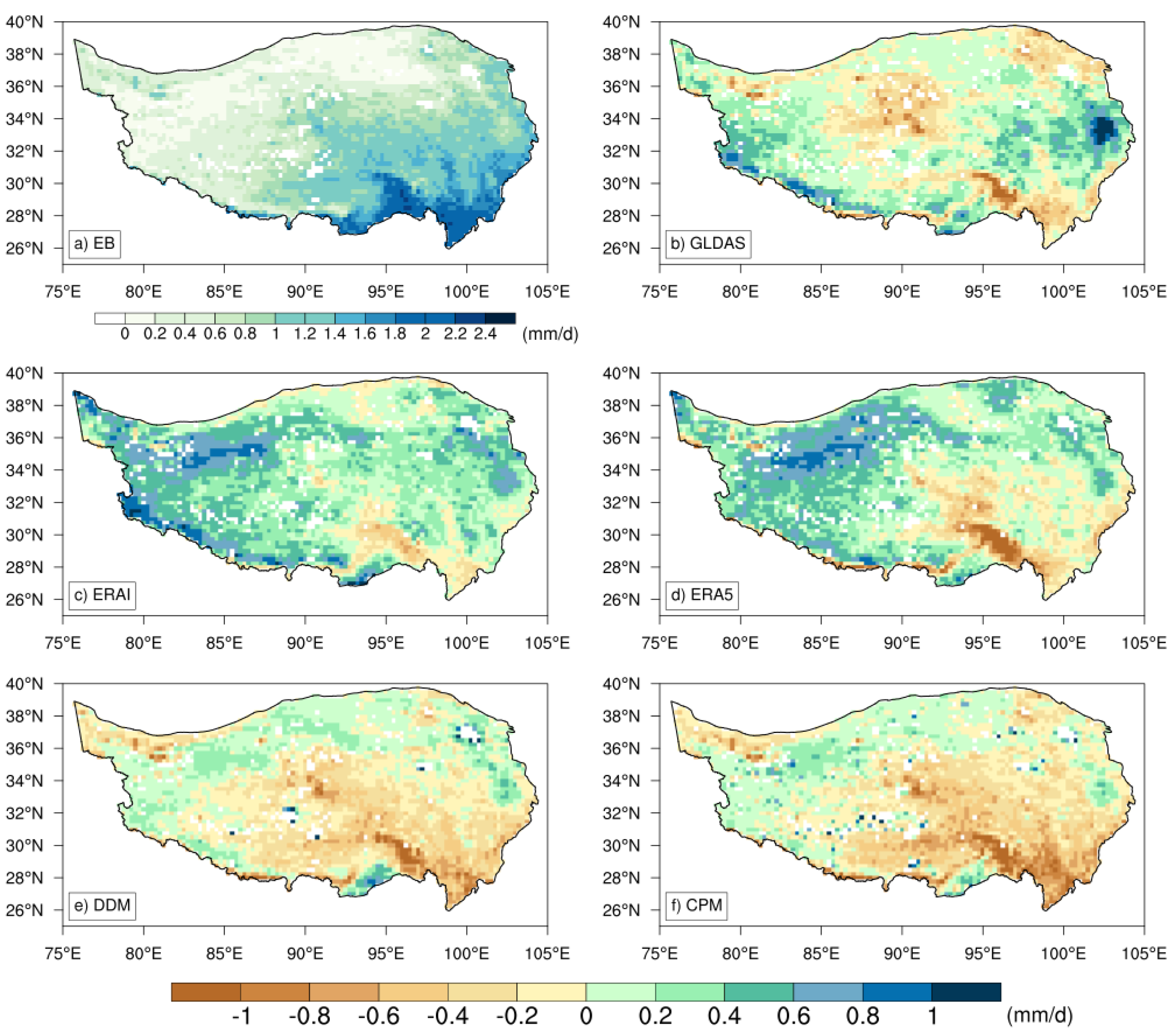
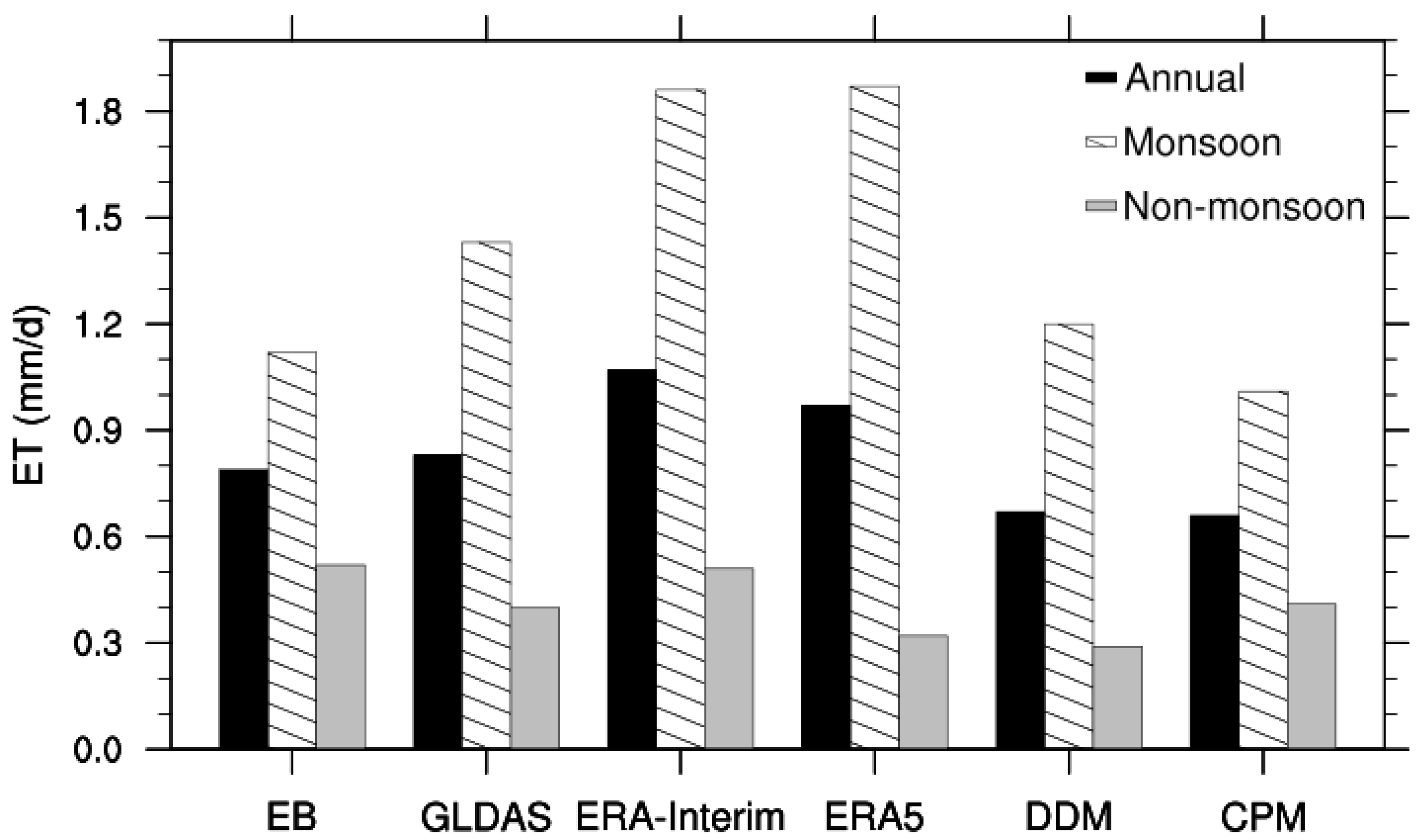

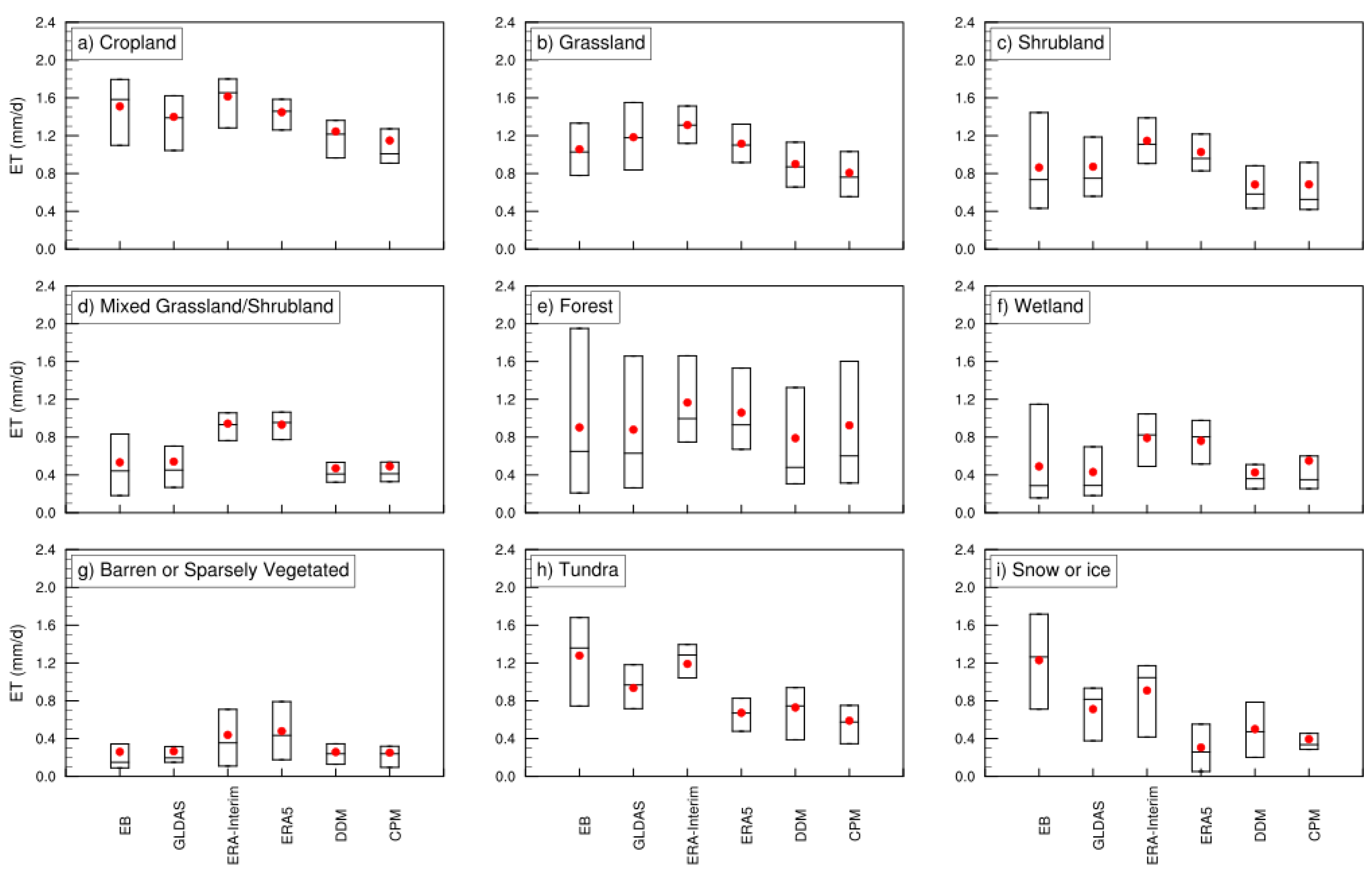
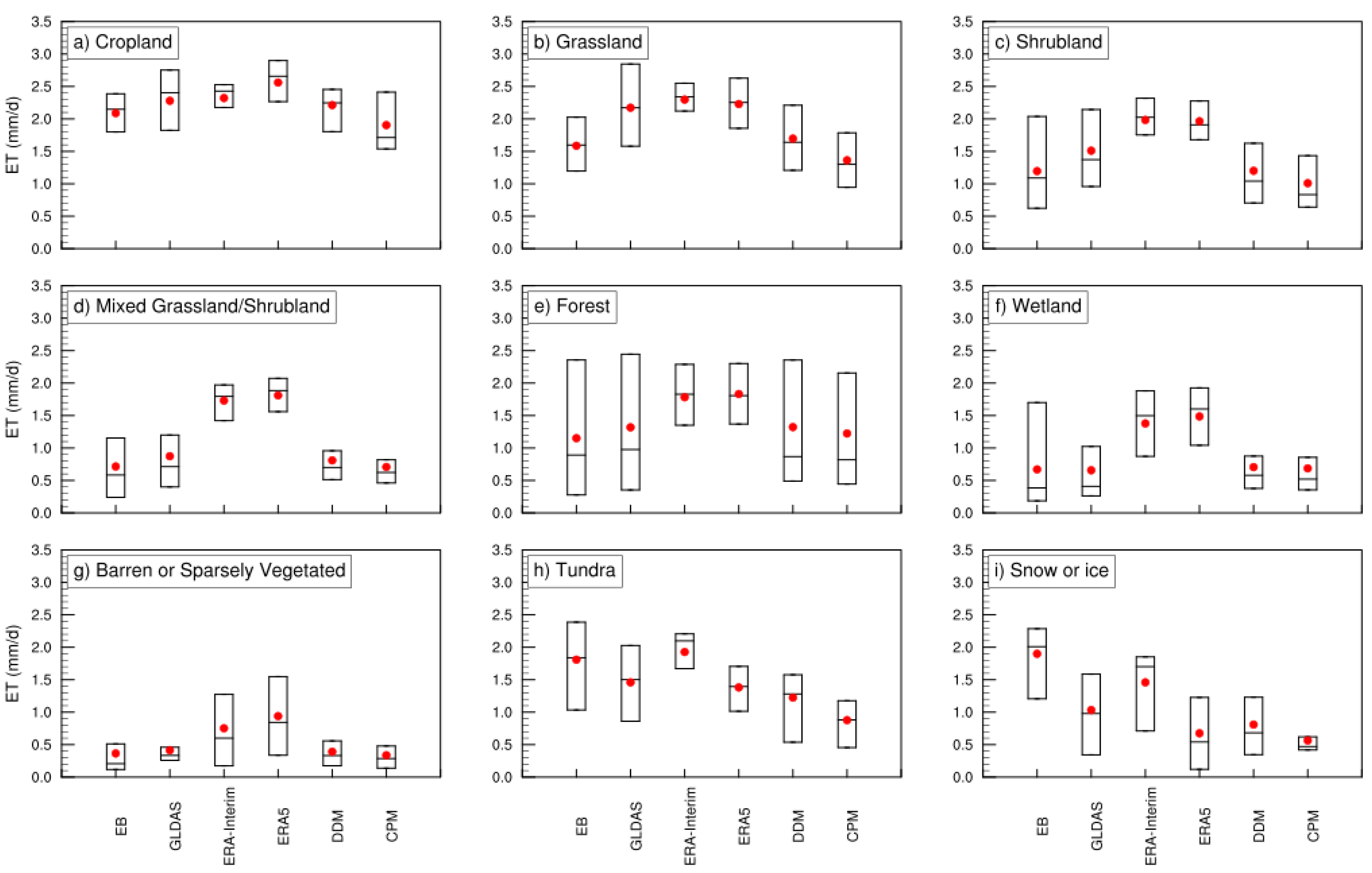

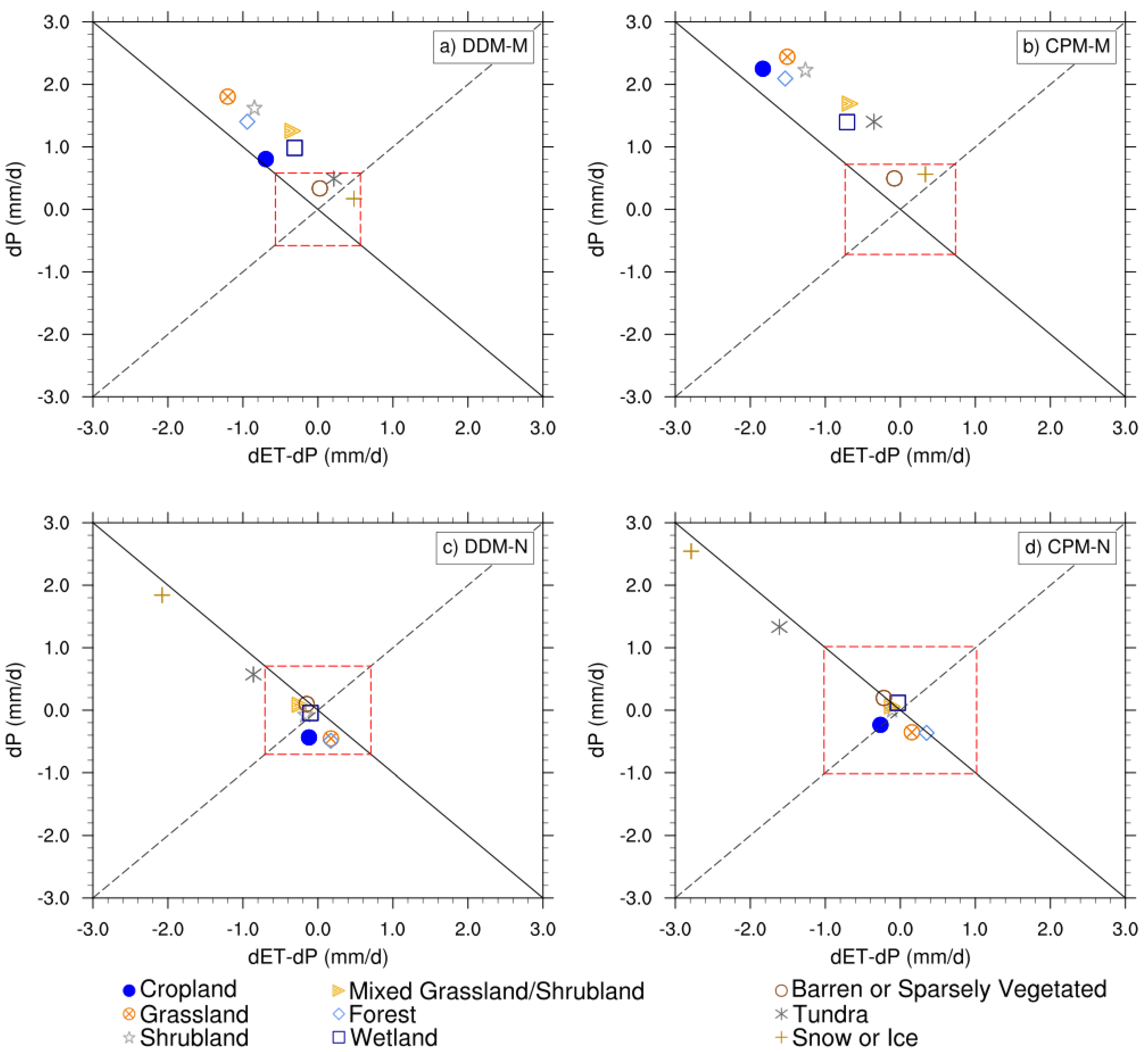

| WRF 3.8 | DDM | CPM |
|---|---|---|
| Domain Region | Eurasian continent (centered at (92.8°E, 37.8°N)) | Tibetan Plateau (75-105°E, 26-40°N) |
| Grid Cells | 280 × 184 | 750 × 414 |
| Horizontal Grid Spacing | 28 km | 4 km |
| Vertical Levels | 27 | |
| Radiation Scheme | CAM (Community Atmosphere Model) [62] | |
| Microphysics Scheme | WSM6 (WRF Single-Moment 6-class microphysics scheme) [63] | |
| Planetary Boundary Layer Scheme | Yonsei University [64] | |
| Convection Scheme | Kain-Fritsch [65] | Explicit |
| Land Surface Model | Noah [66] | |
| Boundary Conditions and SST | ERA-Interim reanalysis | |
| Land Use Category | Land Use Description | USGS (United States Geological Survey) [74] |
|---|---|---|
| 1 | Cropland | 2–6 |
| 2 | Grassland | 7 |
| 3 | Shrubland | 8 |
| 4 | Mixed Shrubland/Grassland | 9-10 |
| 5 | Forest | 11–15 |
| 6 | Water Bodies | 16 |
| 7 | Wetland | 17-18 |
| 8 | Barren or Sparsely Vegetated | 19 |
| 9 | Tundra | 20–23 |
| 10 | Snow or Ice | 24 |
| EB | GLDAS | ERA-Interim | ERA5 | DDM | CPM | ||
|---|---|---|---|---|---|---|---|
| Value (unit: mm/d) | Ann | 0.79 | 0.83 | 1.07 | 0.97 | 0.67 | 0.66 |
| Monsoon | 1.12 | 1.43 | 1.86 | 1.87 | 1.20 | 1.01 | |
| Non-Monsoon | 0.52 | 0.40 | 0.51 | 0.32 | 0.29 | 0.41 | |
| SD | Ann | 0.53 | 0.53 | 0.36 | 0.43 | 0.41 | 0.47 |
| Monsoon | 0.73 | 0.94 | 0.61 | 0.63 | 0.76 | 0.63 | |
| Non-Monsoon | 0.41 | 0.30 | 0.25 | 0.38 | 0.20 | 0.45 | |
| RMSE | Ann | --- | 0.34 | 0.41 | 0.42 | 0.33 | 0.38 |
| Monsoon | --- | 0.65 | 0.89 | 0.95 | 0.46 | 0.47 | |
| Non-Monsoon | --- | 0.30 | 0.21 | 0.37 | 0.38 | 0.38 | |
| CORR | Ann | --- | 0.94 | 0.95 | 0.91 | 0.95 | 0.93 |
| Monsoon | --- | 0.94 | 0.92 | 0.91 | 0.95 | 0.94 | |
| Non-Monsoon | --- | 0.90 | 0.95 | 0.87 | 0.90 | 0.84 | |
| 99% Monte-Carlo Test | ||||||
|---|---|---|---|---|---|---|
| GLDAS | ERA-Interim | ERA5 | DDM | CPM | ||
| Cropland | Ann | * | ||||
| Monsoon | * | |||||
| Non-Monsoon | * | * | * | * | ||
| Grassland | Ann | * | * | * | * | * |
| Monsoon | * | * | * | * | * | |
| Non-Monsoon | * | * | * | * | * | |
| Shrubland | Ann | * | * | * | * | |
| Monsoon | * | * | * | * | ||
| Non-Monsoon | * | * | * | * | ||
| Mixed Shrubland/Grassland | Ann | * | * | * | ||
| Monsoon | * | * | * | * | ||
| Non-Monsoon | * | * | * | |||
| Forest | Ann | * | * | |||
| Monsoon | * | * | ||||
| Non-Monsoon | * | * | * | |||
| Wetland | Ann | * | * | |||
| Monsoon | * | * | ||||
| Non-Monsoon | ||||||
| Barren or Sparsely Vegetated | Ann | * | * | |||
| Monsoon | * | * | ||||
| Non-Monsoon | * | |||||
| Tundra | Ann | * | * | * | * | |
| Monsoon | * | * | * | * | ||
| Non-Monsoon | * | * | * | * | * | |
| Snow or Ice | Ann | * | * | * | ||
| Monsoon | * | * | * | * | ||
| Non-Monsoon | * | |||||
Publisher’s Note: MDPI stays neutral with regard to jurisdictional claims in published maps and institutional affiliations. |
© 2021 by the authors. Licensee MDPI, Basel, Switzerland. This article is an open access article distributed under the terms and conditions of the Creative Commons Attribution (CC BY) license (https://creativecommons.org/licenses/by/4.0/).
Share and Cite
Dan, J.; Gao, Y.; Zhang, M. Detecting and Attributing Evapotranspiration Deviations Using Dynamical Downscaling and Convection-Permitting Modeling over the Tibetan Plateau. Water 2021, 13, 2096. https://doi.org/10.3390/w13152096
Dan J, Gao Y, Zhang M. Detecting and Attributing Evapotranspiration Deviations Using Dynamical Downscaling and Convection-Permitting Modeling over the Tibetan Plateau. Water. 2021; 13(15):2096. https://doi.org/10.3390/w13152096
Chicago/Turabian StyleDan, Jingyu, Yanhong Gao, and Meng Zhang. 2021. "Detecting and Attributing Evapotranspiration Deviations Using Dynamical Downscaling and Convection-Permitting Modeling over the Tibetan Plateau" Water 13, no. 15: 2096. https://doi.org/10.3390/w13152096
APA StyleDan, J., Gao, Y., & Zhang, M. (2021). Detecting and Attributing Evapotranspiration Deviations Using Dynamical Downscaling and Convection-Permitting Modeling over the Tibetan Plateau. Water, 13(15), 2096. https://doi.org/10.3390/w13152096







